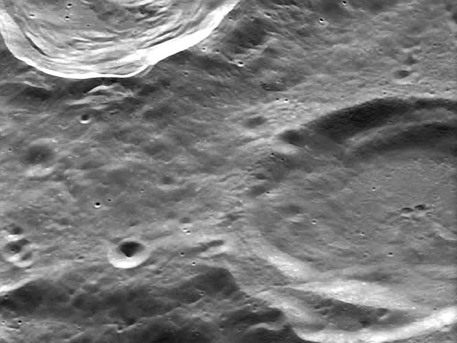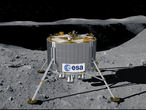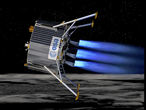Europe explores the Moon
18-month effort begins in Berlin today
 © ESA/SPACE-X Space Exploration Institute
|
Since ancient times, mankind has studied the Moon; however it still holds many secrets as to how it formed and what it is made of. ESA’s Smart-1 was launched in 2003 to reveal some of these mysteries by using an innovative electric propulsion engine powered by solar energy. Scientists all over the world are now analysing over three years of data, including the best surface images ever taken from lunar orbit and accurate information of the Moon’s mineral composition. One of the most exciting discoveries of Smart-1 is an area constantly exposed to the Sun’s rays. This could serve as a base for future manned missions to the Moon.
"It is a great pleasure to see progress being made in Europe in the field of space exploration relying on key technologies developed for human spaceflight," affirmed Mrs Di Pippo.
"As we prepare ourselves to join the US, Russia and Japan in the decision to utilise the International Space Station for 10 more years and beyond," she added, "we are preparing the next steps and we are working to position Europe at the level of its competences and capabilities within the global exploration undertaking.
"With a strong and successful presence in low orbit, the Moon is the next natural goal on our common path to further destinations.
"Europe is actively and successfully present in these global projects, like ISS and exploration, which contribute to affirm our role as a modern, dynamic and innovation-driven continent."
"The proven capabilities of the Automated Transfer Vehicle as a technology demonstration are representative of Astrium’s skills and experience in automated rendezvous and docking procedures," stated Dr Menking, Astrium’s Senior Vice President Orbital Systems and Space Exploration.
"The concept of the new study is based on the technologies of ATV and this unique expertise will enable us to develop the key technologies; it would not be possible to envisage landing a robotic vehicle on the Moon without them."
Europe explores the Moon
18-month effort begins in Berlin today
 © ESA/SPACE-X Space Exploration Institute
|
Since ancient times, mankind has studied the Moon; however it still holds many secrets as to how it formed and what it is made of. ESA’s Smart-1 was launched in 2003 to reveal some of these mysteries by using an innovative electric propulsion engine powered by solar energy. Scientists all over the world are now analysing over three years of data, including the best surface images ever taken from lunar orbit and accurate information of the Moon’s mineral composition. One of the most exciting discoveries of Smart-1 is an area constantly exposed to the Sun’s rays. This could serve as a base for future manned missions to the Moon.
"It is a great pleasure to see progress being made in Europe in the field of space exploration relying on key technologies developed for human spaceflight," affirmed Mrs Di Pippo.
"As we prepare ourselves to join the US, Russia and Japan in the decision to utilise the International Space Station for 10 more years and beyond," she added, "we are preparing the next steps and we are working to position Europe at the level of its competences and capabilities within the global exploration undertaking.
"With a strong and successful presence in low orbit, the Moon is the next natural goal on our common path to further destinations.
"Europe is actively and successfully present in these global projects, like ISS and exploration, which contribute to affirm our role as a modern, dynamic and innovation-driven continent."
"The proven capabilities of the Automated Transfer Vehicle as a technology demonstration are representative of Astrium’s skills and experience in automated rendezvous and docking procedures," stated Dr Menking, Astrium’s Senior Vice President Orbital Systems and Space Exploration.
"The concept of the new study is based on the technologies of ATV and this unique expertise will enable us to develop the key technologies; it would not be possible to envisage landing a robotic vehicle on the Moon without them."








